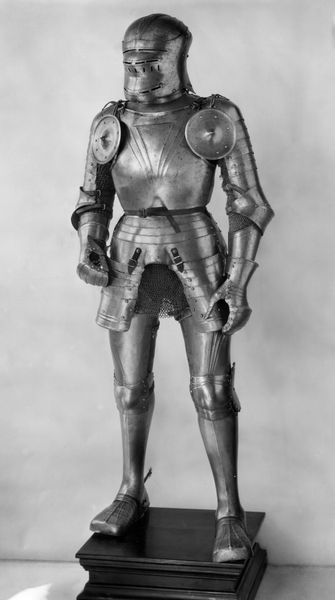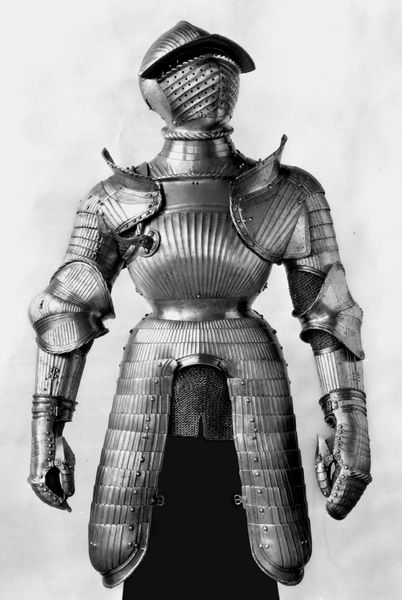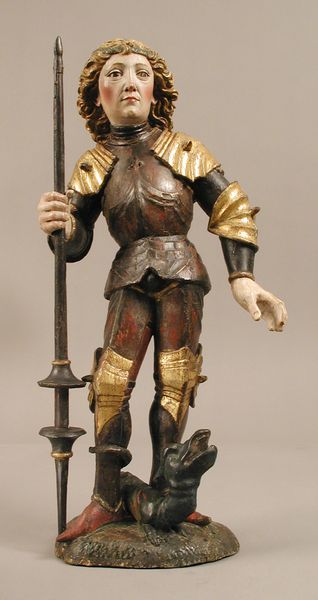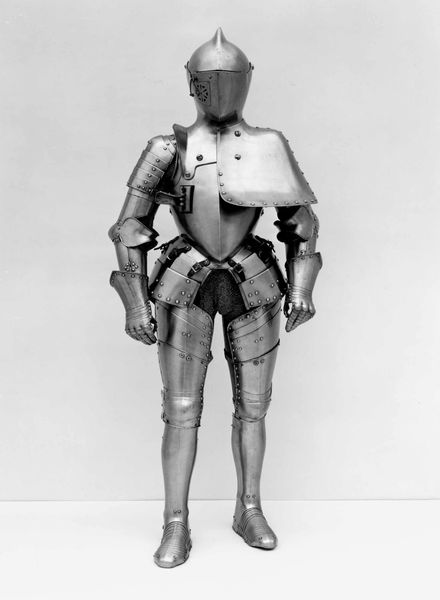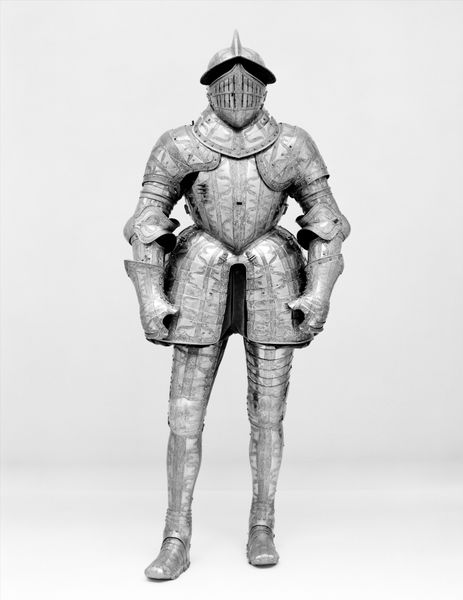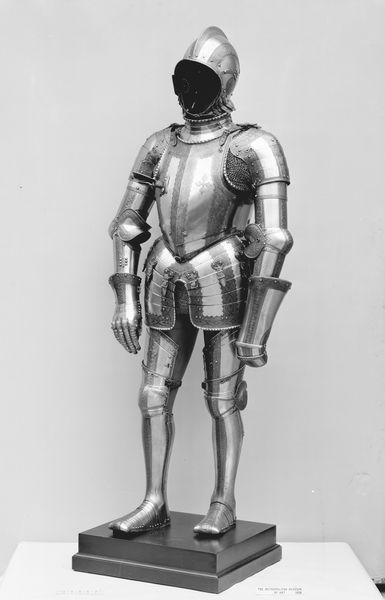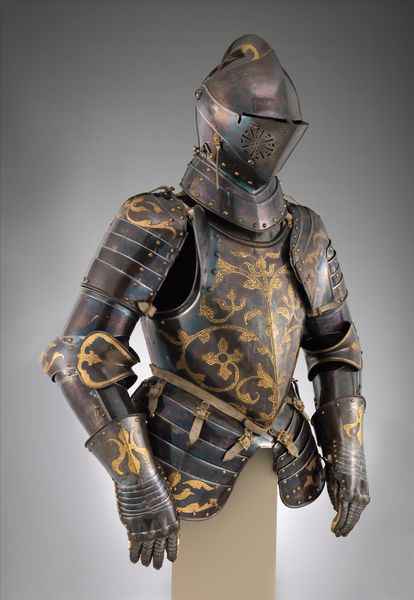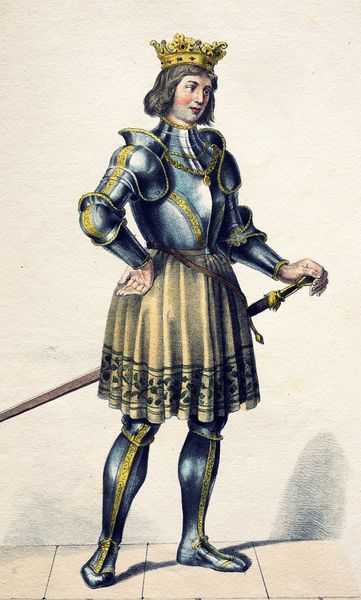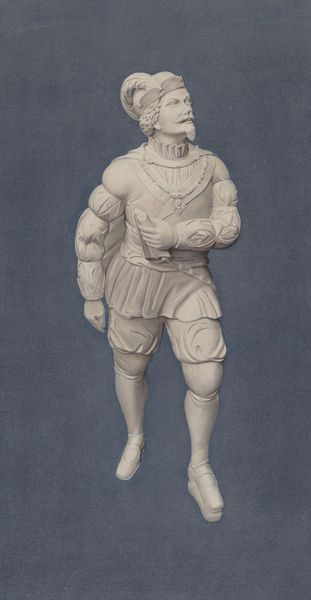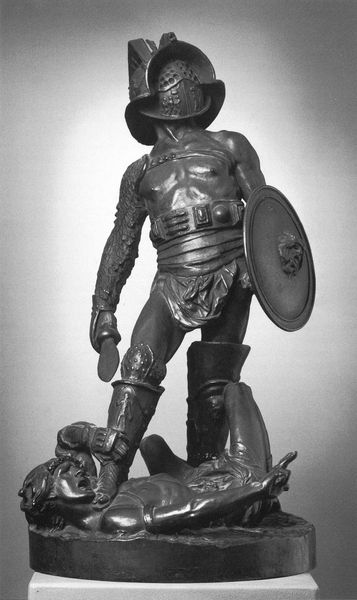
metal, sculpture
#
portrait
#
medieval
#
metal
#
sculpture
#
sculpture
#
armor
Dimensions: Wt. approx. 41 lb. 12 oz. (18.94 kg); 50.160i (gauntlet); L. 11 3/4 in. (29.8 cm); W. 5 3/8 in. (13.7 cm); D. 5 in. (12.7 cm); Wt. 1 lb. (453.6 g); 50.160h (elbow reinforce); H. 8 3/8 in. (21.3 cm); W. 4 1/4 in. (10.8 cm); D. 9 1/2 in. (24.1 cm); Wt. 12.2 oz. (345.9 g); 50.160o (greave); H. 14 13/16 in. (37.6 cm); W. 4 5/8 in. (11.7 cm); D. 5 5/16 in. (13.5 cm); Wt. 1 lb. 9.2 oz. (714.4 g); 50.160n (thigh defense); H. 20 3/8 in. (51.8 cm); W. 6 11/16 in. (17 cm); D. 7 1/2 in. (19.1 cm); Wt. 4 lb. 5.5 oz. (1970.3 g); 50.160u (mail collar with integral bevor); H. 15 5/8 in. (37 cm); W. 31 5/16 in. (79.5 cm); Diam. (outside) of collar links 11/32 in. (8.3 mm); Diam. (inside) of collar links 7/32 in. (5.9 mm); Diam. (outside) of shawl links 5/16 in. (7.7 mm); Diam. (inside) of shawl links 1/4 in. (6.3 mm); 50.160v (mail sleeve); L. 29 1/8 in. (74 cm) W. 13 in. (33 cm); Diam. (outside) of links, 9/32 in. (7.2 mm); Diam. (inside) of links, 3/16 in. (5 mm); 50.160w (mail sleeve): L. 27 5/8 in. (70.0 cm); W. 12 3/16 in. (31.0 mm); Diam. (outside) of links 9/32 in. (6.8 mm); Diam. (inside) of links, 3/16 in. (4.6 mm); 50.160x (pair of mail paunces); H. 8 11/16 in. (22 cm); H. of skirt 14 13/16 in. (37.5 cm); W. of bravette 26 in. (66 cm); Diam. of waist 32 1/8 in. (81.5 cm); Diam. (outside) of links 13/32 in. (10.6 mm); Diam. (inside) of links, 7/32 in. (5.6 mm)
Copyright: Public Domain
Curator: Looking at this "Composed Armor," dated sometime between 1400 and 1900 and housed here at the Met, I can't help but feel a little intimidated, to be honest. It's formidable, even in stillness. What’s your initial reaction to it? Editor: A certain chill runs down my spine, not only because it’s crafted from cold metal, but because of its aura. It's not just a sculpture; it's a representation of power, hierarchy, and potentially violence solidified into physical form. I imagine that power has everything to do with who could afford to pay for such intricate craftmanship and, thus, access to violence on such scale. Curator: Exactly. The craftsmanship is stunning, intricate layers all pieced together to be like a metallic wearable fort. The curves, the polish... it feels like a strangely beautiful contraption of war. But it’s a bit tragic isn't it? All that protection points towards real vulnerability. Editor: Indeed. This piece speaks volumes about societal anxieties of the time. Who needed that much protection? The material reminds me how much the armor reflects the societal inequalities inherent in medieval hierarchies of the time: only certain bodies were worth defending with such investment. Curator: You know, the Met states that this piece of armor is composed. Could that signal something too about the fabrication of the elite’s identities? What does protection offer, when its beauty seems also a form of propaganda, an ideal to live up to. Editor: That's perceptive. "Composed Armor," the artwork's name, does feel significant in revealing how intertwined defense and identity were, both built up piece by piece. Think about the message this armor sends: I am powerful, protected, and worthy of awe – but also, I fear. This armor invites us to contemplate the theater of power, and maybe even more deeply: what, if anything, has changed between then and now? Curator: It makes you consider, perhaps we all walk around in a kind of armor. Some metaphorical, some a bit more literal, of course. Food for thought there... Thank you for shedding new light on it for me! Editor: The pleasure was all mine. Thinking critically about artifacts from the past invites reflection about our world today; seeing this "Composed Armor," forces us to remember power dynamics never vanish, only change costumes.
Comments
No comments
Be the first to comment and join the conversation on the ultimate creative platform.

